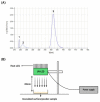Investigating the Use of Ultraviolet Light Emitting Diodes (UV-LEDs) for the Inactivation of Bacteria in Powdered Food Ingredients
- PMID: 33917815
- PMCID: PMC8068219
- DOI: 10.3390/foods10040797
Investigating the Use of Ultraviolet Light Emitting Diodes (UV-LEDs) for the Inactivation of Bacteria in Powdered Food Ingredients
Abstract
The addition of contaminated powdered spices and seasonings to finished products which do not undergo further processing represents a significant concern for food manufacturers. To reduce the incidence of bacterial contamination, seasoning ingredients should be subjected to a decontamination process. Ultraviolet light emitting diodes (UV-LEDs) have been suggested as an alternative to UV lamps for reducing the microbial load of foods, due to their increasing efficiency, robustness and decreasing cost. In this study, we investigated the efficacy of UV-LED devices for the inactivation of four bacteria (Listeria monocytogenes, Escherichia coli, Bacillus subtilis and Salmonella Typhimurium) on a plastic surface and in four powdered seasoning ingredients (onion powder, garlic powder, cheese and onion powder and chilli powder). Surface inactivation experiments with UV mercury lamps, UVC-LEDs and UVA-LEDs emitting at wavelengths of 254 nm, 270 nm and 365 nm, respectively, revealed that treatment with UVC-LEDs were comparable to, or better than those observed using the mercury lamp. Bacterial reductions in the seasoning powders with UVC-LEDs were less than in the surface inactivation experiments, but significant reductions of 0.75-3 log10 colony forming units (CFU) were obtained following longer (40 s) UVC-LED exposure times. Inactivation kinetics were generally nonlinear, and a comparison of the predictive models highlighted that microbial inactivation was dependent on the combination of powder and microorganism. This study is the first to report on the efficacy of UV-LEDs for the inactivation of several different bacterial species in a variety of powdered ingredients, highlighting the potential of the technology as an alternative to the traditional UV lamps used in the food industry.
Keywords: LED; bacteria; foods; inactivation; powder; ultraviolet.
Conflict of interest statement
The authors declare no conflict of interest.
Figures




Similar articles
-
Using UVC Light-Emitting Diodes at Wavelengths of 266 to 279 Nanometers To Inactivate Foodborne Pathogens and Pasteurize Sliced Cheese.Appl Environ Microbiol. 2015 Sep 18;82(1):11-7. doi: 10.1128/AEM.02092-15. Print 2016 Jan 1. Appl Environ Microbiol. 2015. PMID: 26386061 Free PMC article.
-
Elevated Inactivation Efficacy of a Pulsed UVC Light-Emitting Diode System for Foodborne Pathogens on Selective Media and Food Surfaces.Appl Environ Microbiol. 2018 Oct 1;84(20):e01340-18. doi: 10.1128/AEM.01340-18. Print 2018 Oct 15. Appl Environ Microbiol. 2018. PMID: 30097449 Free PMC article.
-
Microorganisms inactivation by wavelength combinations of ultraviolet light-emitting diodes (UV-LEDs).Sci Total Environ. 2019 May 15;665:1103-1110. doi: 10.1016/j.scitotenv.2019.02.041. Epub 2019 Feb 8. Sci Total Environ. 2019. PMID: 30893742
-
Recent advances on the application of UV-LED technology for microbial inactivation: Progress and mechanism.Compr Rev Food Sci Food Saf. 2020 Nov;19(6):3501-3527. doi: 10.1111/1541-4337.12645. Epub 2020 Oct 11. Compr Rev Food Sci Food Saf. 2020. PMID: 33337035 Review.
-
A Comprehensive Analysis of the UVC LEDs' Applications and Decontamination Capability.Materials (Basel). 2022 Apr 13;15(8):2854. doi: 10.3390/ma15082854. Materials (Basel). 2022. PMID: 35454546 Free PMC article. Review.
Cited by
-
Emerging Non-Thermal Food Processing Technologies: Editorial Overview.Foods. 2022 Mar 29;11(7):1003. doi: 10.3390/foods11071003. Foods. 2022. PMID: 35407091 Free PMC article.
-
Continuous and Pulsed Ultraviolet-C LED on Germicidal Effect and Energy Consumption in Fresh Products: Applications in Tomatoes as a Model.Foods. 2022 Nov 14;11(22):3636. doi: 10.3390/foods11223636. Foods. 2022. PMID: 36429226 Free PMC article.
-
Beneficial Effects of Organosulfur Compounds from Allium cepa on Gut Health: A Systematic Review.Foods. 2021 Jul 21;10(8):1680. doi: 10.3390/foods10081680. Foods. 2021. PMID: 34441457 Free PMC article. Review.
-
A comprehensive review on ultraviolet disinfection of spices and culinary seeds and its effect on quality.Compr Rev Food Sci Food Saf. 2025 Jan;24(1):e70076. doi: 10.1111/1541-4337.70076. Compr Rev Food Sci Food Saf. 2025. PMID: 39674832 Free PMC article. Review.
-
Effect of ultraviolet light-emitting diode processing on fruit and vegetable-based liquid foods: A review.Front Nutr. 2022 Nov 29;9:1020886. doi: 10.3389/fnut.2022.1020886. eCollection 2022. Front Nutr. 2022. PMID: 36523335 Free PMC article. Review.
References
-
- Sagoo S.K., Little C.L., Greenwood M., Mithani V., Grant K.A., McLauchlin J., de Pinna E., Threlfall E.J. Assessment of the microbiological safety of dried spices and herbs from production and retail premises in the United Kingdom. Food Microbiol. 2009;26:39–43. doi: 10.1016/j.fm.2008.07.005. - DOI - PubMed
Grants and funding
LinkOut - more resources
Full Text Sources
Other Literature Sources

